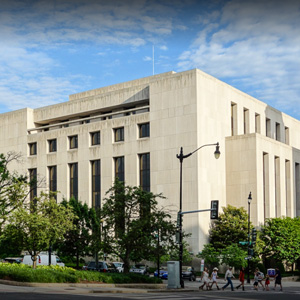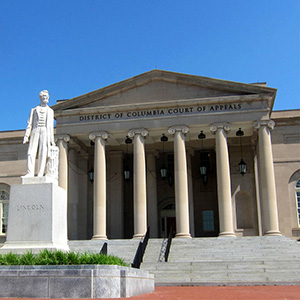Judicial & Bar Conference Offers Look Into the Future of Law
April 29, 2025
Artificial intelligence and its impact on the legal profession was the central topic of discussion at the 2025 Judicial & Bar Conference on April 25 that drew nearly 500 attendees.
Held at the Ronald Reagan Building and International Trade Center, the conference opened with reports on the state of the D.C. Court of Appeals and D.C. Superior Court and highlighted the D.C. Bar’s accomplishments in the current fiscal year, including its emphasis on training lawyers for the future of law.
A plenary session on the rise of AI explored the technology’s impact on access to justice, legal practice, pro bono work, and legal education. Howard University School of Law Dean Roger A. Fairfax Jr., who moderated the discussion, shared that he used a popular AI tool to generate question prompts for lawyers about how AI is transforming the legal profession.
“I was encouraged to touch upon client-services benefits of automated tasks, expanding lawyer bandwidth, enhancing efficiency,” said Fairfax. “I was also encouraged to ask about billing models [and] the pricing of legal services. And finally, I was encouraged to ask you about ethical implications and AI’s role in perpetuating bias in the legal profession … and also concerns about accuracy and liability.”
Brian Schwalb, attorney general for the District of Columbia, noted that AI, “on the positive side,” is something that the legal community must embrace in terms of managing resources and budgets. But being a lawyer “is not just about doing the work; it’s [also about] bringing ethical, human judgment to bear,” he said.
Schwalb said he worries that the more people defer to machine-learning, the more human judgment, relationships, and ethics erode. “One area of the law that we’re going to have to be vigilant about is getting very smart about the downside where big data and artificial intelligence can be used very effectively to take advantage of people,” Schwalb said. “It will be on us as a profession to protect people.”
George L. Washington Jr., chief litigation counsel for Orange Business Services, likened law firm adoption of the technology to a three-lane highway where some refuse to use AI, some are leery, and some are incorporating it at an accelerated pace. Whether law firms adopt or ignore AI will help determine their value proposition to potential clients, Washington said.
“Those firms that are successful at incorporating AI in ways that will allow them to get things done much faster, get better advice, and get back to clients more responsibly are going to be the firms that excel,” Washington said. “But for some things, you cannot replace that human connection.”
However, Washington cautioned that while there is great potential in AI, it’s not going to work at every firm or for every situation.
Closing the Access to Justice Gap
The panel also explored how legal aid organizations could leverage AI to provide more help to pro se litigants. Vikram Swaruup, executive director of Legal Aid DC, said there is great potential in using AI to provide litigants basic legal information, some legal advice with the appropriate safeguards, and assistance with the completion of basic legal forms.
However, cheap AI models are bad for legal services because of their tendency to hallucinate cases, and upgraded models may be cost prohibitive, creating a gap between the haves and have nots, Swaruup said. “If we are pushing more and more traditional direct legal services into AI, how does it work for those people who aren’t going to be able to access that?” he asked.
Swaruup also argued that the country “is not going in the right direction” on access to justice, noting that funding for legal aid organizations through the Legal Services Corporation (which is funded by the U.S. Congress) has not kept up with inflation. While some state and local governments have stepped up, funding for access to justice services remains fragile.
“So, when there’s an economic downturn, [legal aid] programs … are often eliminated right as the need for those services increases,” Swaruup said.
Gwendolyn Prothro Renigar, chair of Steptoe LLP, offered a Big Law perspective, saying that a law firm’s pro bono efforts should be the easiest selling point for recruiting young associates because it provides them an opportunity to do good. At Steptoe, attorneys who do pro bono work get 200 hours of billable credit. “That has really worked well for our associates,” Renigar said.
Schwalb, on the other hand, shared his fear that efforts to close the access to justice gap now lean too heavily on lawyers providing pro bono services. What the United Stats needs is more investment in public schools, health, and housing, Schwalb said.
“As we go downstream and expect courts that don’t have enough judges and resources to deal with unrepresented parties, even as we try to encourage people to do pro bono, we are going to undermine the confidence that anybody has that the justice system works,” Schwalb said. “When people stop thinking that they can get justice, they are going to resolve their disagreements in other ways.”
Training Future Lawyers
The panelists also touched upon the future of law schools and the legal profession. With law school becoming cost prohibitive for many people, Swaruup worries that law students and recent law school graduates will be more reticent to pursue public service. “We need to think really critically about how to address that issue on the front end, when students are coming into law school, and how to prepare them [in a way] that is not cost prohibitive.”
On the positive side, Swaruup said he’s seen an increase in experimental programs for law students. “If you’re coming into an organization like [Legal Aid DC], [understanding] substantive law, the process of law, and how to build relationships with clients is too much,” Swaruup said. “So, having the opportunity to do some [experimental training] in law school has been tremendously important. That’s been a real positive development in the legal profession.”
Ensuring that the legal profession reflects the communities it serves is another challenge, according to Schwalb. “How do we have a commitment to being equitable in our profession when DEI is under attack? Therefore, the way in which we recruit lawyers is changing,” Schwalb said.
“That’s going to be a challenge for law schools in instilling into people that there still is value in the rule of law that will prevail in this moment so that people will commit their time and dollars to going to law school,” he continued.
Washington brought the conversation back to AI by mentioning the now-popular existential question: Is AI going to replace lawyers? Washington is confident that it won’t, but he noted that lawyers who know how to use AI in their practice are going to replace those who don’t.
“Law schools, very soon, are going to have to develop programs and certifications for training lawyers how to use [AI tools],” Washington said.
Opportunities and Regulatory Challenges
Many of the same talking points and perspectives were reiterated during a fireside chat with Ed Walters, chief strategy officer at vLex; Victoria A. Espinel, CEO of the Business Software Alliance; and Miriam Vogel, president and CEO of EqualAI.
The panelists agreed that AI has been both unprecedented and transformational, akin to when the internet first emerged and changed the way most people live and work. On the question of whether use of generative AI will reduce billable hours for lawyers and firms, Vogel said she doesn’t know, but the hope is that lawyers will now spend less time on routine tasks.
Walters, Vogel, and Espinel also stressed the importance of consistent regulation of AI. “The Biden administration established several executive orders that have been rescinded by the current administration,” Walters said before asking the panelists whether Congress should regulate AI or leave it to the states.
“Would it be helpful if we had clarity on the national level on what the expectations are [in administering] AI governance … in ways that will have a meaningful impact on somebody’s life? Absolutely,” Vogel responded.
“Congress should have a role,” Espinel chimed in. “But Congress is not where the action is. There’s just so many other priorities on their plate.” She noted that the Trump administration is reportedly working on an AI action plan and that Colorado was the first U.S. state to pass a comprehensive AI bill.
“There is no question that there [eventually] will be regulations,” Espinel said. “But one of my concerns is how many different kinds of regulations [are] we are going to end up with?” Competing regulations will not be good for businesses, Espinel said.
In terms of the legal profession’s responsibilities in shaping AI regulations, Espinel said that law firms, companies, and institutions need to have internal processes regarding AI usage. “It’s important that companies put in place [AI] governance committees,” she said. “And having it truly across departmental is very important.”





